Aerodynamic Loading and Wind-Induced Vibration Characteristics of Bridge Girders with Typical Asymmetric Configurations
Abstract
1. Introduction
2. Research Background and Experimental Setup
2.1. Details of the Bridges
2.2. Test and Numerical Setup
2.2.1. Static Wind Loading Test
2.2.2. Flutter Derivative Identification Test
2.2.3. VIV Test
2.2.4. Flutter Test
2.2.5. Numerical Setup
3. Results and Discussions
3.1. Static Wind Loading Coefficient
3.2. Flutter Derivative
3.3. VIV Response
3.4. Critical Flutter Velocity
4. Conclusions
- (1)
- The asymmetric girder configurations have an obvious effect on the static wind loading coefficients for the two types of bridge girders. The mean flow structures and patterns differ markedly between 0° and 180° WDAs, leading to large discrepancies in the static wind loading coefficients at the specified AOA.
- (2)
- The effect of WDA on the flutter derivatives of the asymmetric Π-shaped girder is more pronounced than that on the asymmetric box girder. The flutter derivative of of the two types of asymmetric bridge girders is much smaller in a WDA of 0° than that at a 180° WDA at high reduced wind velocities. This implies that the 0° WDA from the side of the asymmetric bikeway can provide more torsional aerodynamic damping, which is beneficial for enhancing the flutter stability of the bridge.
- (3)
- For the asymmetric Π-shaped girder, the heaving VIV responses at a 0° WDA are smaller than those at a 180° WDA. A cluster of large-scale vortices beneath the girder at a 180° WDA. These vortices generate intense suction, producing large fluctuating lift forces that amplify the heaving VIV responses relative to a 0° WDA. However, the torsional VIV responses at a 0° WDA are larger than those at a 180° WDA. Additional vortices cluster near the upper deck, especially on the leeward side, where a more intense alternating vortex street forms. This enhanced wake excitation generates larger torsional forces, thereby amplifying the torsional VIV response.
- (4)
- The flutter performances of two kinds of asymmetric bridge girders are very different between different WDAs. The critical flutter velocity at a 0° WDA is higher than that at a 180° WDA, especially at positive AOAs. It is inferred that for the asymmetric Π-shaped girder, the windward bikeway acts similarly to a horizontal plate, improving bridge girder flutter performance. For the asymmetric box girder, the railing assembly along the windward bikeway serves as a vertical stabilizer, resulting in enhanced critical flutter wind velocities.
Author Contributions
Funding
Institutional Review Board Statement
Informed Consent Statement
Data Availability Statement
Acknowledgments
Conflicts of Interest
References
- Zhao, L.; Cui, W.; Shen, X.; Xu, S.; Ding, Y.; Ge, Y. A fast on-site measure-analyze-suppress response to control vortex-induced-vibration of a long-span bridge. Structures 2022, 35, 192–201. [Google Scholar] [CrossRef]
- Yang, F.; Zhang, X.; Xie, Z.; Hao, J. Wind performance of new and existing continuous beam bridges during construction stages. Buildings 2025, 15, 791. [Google Scholar] [CrossRef]
- Yang, Y.; Li, L.; Yao, G.; Wu, B.; Wang, D.; Yu, H.; Qu, H. Study on the influence of wind fairing parameters on the aerodynamic performance of long-span double-deck steel truss suspension bridge. Buildings 2024, 14, 2255. [Google Scholar] [CrossRef]
- Li, S.; Wang, P.; Wu, Y.; Zou, Y.; Yang, Q.; Tian, J.; Zhou, Y. Experiment study on vortex-induced vibration of variable cross-section bridge tower considering alongwind and acrosswind coupling effect. Eng. Struct. 2025, 327, 119678. [Google Scholar] [CrossRef]
- Li, M.; Li, M.; Yang, Y.; Li, S. On the refined buffeting analysis of long-span bridges: Which is the proper aerodynamic admittance? Adv. Wind Eng. 2025, 2, 100025. [Google Scholar] [CrossRef]
- Li, M.; Li, M.; Zhong, Y.; Luo, N. Buffeting response evaluation of long-span bridges with emphasis on the three-dimensional effects of gusty winds. J. Sound Vib. 2019, 439, 156–172. [Google Scholar] [CrossRef]
- Li, M.; Li, M.; Sun, Y. Effects of turbulence integral scale on the buffeting response of a long-span suspension bridge. J. Sound Vib. 2021, 490, 115721. [Google Scholar] [CrossRef]
- Su, Y.; Li, M.; Di, J.; Sun, R.; Li, M.; Qin, F.; Jiang, Y.; Wang, J. Scale effects on buffeting response of long-span bridges. Eng. Struct. 2025, 341, 120862. [Google Scholar] [CrossRef]
- Li, C.; Zou, M.; Li, K.; Han, Y.; Yan, H.; Cai, C. A study on post-flutter characteristics of a large-span double-deck steel truss main girder suspension bridge. Buildings 2024, 14, 3206. [Google Scholar] [CrossRef]
- Russo, S.; Piana, G.; Patruno, L.; Carpinteri, A. Preliminary flutter stability assessment of the double-deck George Washington bridge. Appl. Sci. 2023, 13, 6389. [Google Scholar] [CrossRef]
- Wu, B.; Li, M.; Wu, L.; Shen, H.; Liao, H.; Mei, H. Study on aerodynamic forces and aeroelasticity of an oscillating 5: 1 rectangular cylinder in smooth and turbulent flow. J. Fluids Struct. 2025, 137, 104371. [Google Scholar] [CrossRef]
- Zhang, T.; Cui, X.; Zhang, X.; Li, H.; Zou, Y. Flutter reliability analysis of Xiangshan harbor highway cable-stayed bridges in service. Appl. Sci. 2022, 12, 8301. [Google Scholar] [CrossRef]
- Li, M.; Li, M.; Su, Y. Experimental determination of the two-dimensional aerodynamic admittance of typical bridge decks. J. Wind Eng. Ind. Aerodyn. 2019, 193, 103975. [Google Scholar] [CrossRef]
- Sun, Y.; Li, M.; Li, M.; Liao, H. Spanwise correlation of vortex-induced forces on typical bluff bodies. J. Wind Eng. Ind. Aerodyn. 2019, 189, 186–197. [Google Scholar] [CrossRef]
- Qin, C.; Li, M.; Li, M. Research on the vortex-induced vibration and aerodynamic mitigation measures of parallel Π-shaped girders under aerodynamic interference effects. Structures 2025, 71, 107996. [Google Scholar] [CrossRef]
- Jian, B.; Li, M.; Li, M.; Su, Y. Influence of wind yaw angle and pylon interference on the buffeting responses of cable-stayed bridges during construction. Struct. Infrastruct. Eng. 2022, 18, 1350–1364. [Google Scholar] [CrossRef]
- Bai, H.; Ji, N.; Xu, G.; Li, J. An alternative aerodynamic mitigation measure for improving bridge flutter and vortex induced vibration (VIV) stability: Sealed traffic barrier. J. Wind Eng. Ind. Aerodyn. 2020, 206, 104302. [Google Scholar] [CrossRef]
- Junruang, J.; Boonyapinyo, V. Vortex induced vibration and flutter instability of two parallel cable-stayed bridges. Wind Struct. 2020, 30, 633–648. [Google Scholar]
- Li, S.; Li, X.; Jiang, Y.; Li, T.; Wang, Y. Non-stationary aerodynamic characteristics of the rectangular cylinder in downburst-like flow. Phys. Fluids. 2025, 37, 025145. [Google Scholar]
- Wang, Y.; Chen, X.; Li, Y. Nonlinear self-excited forces and aerodynamic damping associated with vortex-induced vibration and flutter of long span bridges. J. Wind Eng. Ind. Aerodyn. 2020, 204, 104207. [Google Scholar] [CrossRef]
- Tang, H.; Zhang, H.; Mo, W.; Li, Y. Flutter performance of box girders with different wind fairings at large angles of attack. Wind Struct. 2021, 32, 509–520. [Google Scholar]
- Ueda, T.; Yasuda, M.; Nakagaki, R. Mechanism of aerodynamic stabilization for long-span suspension bridge with stiffening truss-girder. J. Wind Eng. Ind. Aerodyn. 1990, 33, 333–340. [Google Scholar] [CrossRef]
- Yang, Y.; Zhou, R.; Ge, Y.; Zou, X.; Zhang, L. Flutter characteristics of twin-box girder bridges with vertical central stabilizers. Eng. Struct. 2017, 133, 33–48. [Google Scholar] [CrossRef]
- Mei, H.; Wang, Q.; Liao, H.; Fu, H. Improvement of flutter performance of a box girder by using an upper central stabilizer. J. Bridge Eng. 2020, 25, 04020053. [Google Scholar] [CrossRef]
- Li, M.; Sun, Y.; Lei, Y.; Liao, H.; Li, M. Experimental study of the nonlinear torsional flutter of a long-span suspension bridge with a double-deck truss girder. Int. J. Struct. Stab. Dyn. 2021, 21, 2150102. [Google Scholar] [CrossRef]
- Sun, Y.; Lei, Y.; Li, M.; Liao, H.; Li, M. Flutter mitigation of a superlong-span suspension bridge with a double-deck truss girder through wind tunnel tests. J. Vib. Control. 2021, 27, 1584–1594. [Google Scholar] [CrossRef]
- Yang, Y.; Zhu, J.; Hong, L.; Ge, Y.; Su, R.; Yang, H.; Zhou, R. Effect mechanism of wind barriers on flutter characteristics of closed box girders with different aspect ratios. J. Bridge Eng. 2023, 28, 04023065. [Google Scholar] [CrossRef]
- Kobayashi, H.; Nagaoka, H. Active control of flutter of a suspension bridge. J. Wind Eng. Ind. Aerodyn. 1992, 41, 143–151. [Google Scholar] [CrossRef]
- Zhuo, L.; Liao, H.; Li, M. Flutter control of a box girder with active flaps. J. Vib. Control 2021, 27, 662–674. [Google Scholar] [CrossRef]
- Wang, Z.; Fang, G.; Li, K.; Zhao, L. Flutter control mechanism of dual active aerodynamic flaps with adjustable mounting distance for a bridge girder. Struct. Control Health Monit. 2024, 2024, 5259682. [Google Scholar] [CrossRef]
- Bruno, L.; Salvetti, M.V.; Ricciardelli, F. Benchmark on the aerodynamics of a rectangular 5:1 cylinder: An overview after the first four years of activity. J. Wind Eng. Ind. Aerodyn. 2014, 126, 87–106. [Google Scholar] [CrossRef]
- Chen, Y.; Wang, X.; Sun, C.; Zhu, B. Exploring the failure mechanism of light poles on elevated bridges under high winds. Eng. Fail. Anal. 2024, 159, 108076. [Google Scholar] [CrossRef]
- Ricci, M.; Patruno, L.; de Miranda, S.; Ubertini, F. Flow field around a 5: 1 rectangular cylinder using LES: Influence of inflow turbulence conditions, spanwise domain size and their interaction. Comput. Fluids 2017, 149, 181–193. [Google Scholar] [CrossRef]
- Tongaria, K.; Gogulapati, A.; Chandiramani, N.K. Identification of flutter boundary of a bridge deck section using CFD and flutter margin analysis. J. Wind Eng. Ind. Aerodyn. 2024, 246, 105680. [Google Scholar] [CrossRef]
- Verma, S.; Montoya, M.C.; Mishra, A. Shape-and frequency-dependent self-excited forces emulation for the aero-structural design of bluff deck bridges. J. Wind Eng. Ind. Aerodyn. 2024, 252, 105769. [Google Scholar] [CrossRef]
- Zhang, W.; Feng, D.; Zhao, L.; Ge, Y. A deep learning-based method for full-bridge flutter analysis considering aerodynamic and geometric nonlinearities. Comput. Struct. 2025, 310, 107693. [Google Scholar] [CrossRef]
- Kavrakov, I.; Morgenthal, G.; McRobie, A. Data-driven aeroelastic analyses of structures in turbulent wind conditions using enhanced Gaussian processes with aerodynamic priors. J. Wind Eng. Ind. Aerodyn. 2024, 253, 105848. [Google Scholar] [CrossRef]
- Nagao, F.; Utsunomiya, H.; Yoshioka, E.; Ikeuchi, A.; Kobayashi, H. Effects of handrails on separated shear flow and vortex-induced oscillation. J. Wind Eng. Ind. Aerodyn. 1997, 69–71, 819–827. [Google Scholar] [CrossRef]
- Larose, G.L.; Larsen, S.V.; Larsen, A.; Hui, M.; Jensen, A. Sectional model experiments at high Reynolds number for the deck of a 1018 m span cable-stayed bridge. In Proceedings of the 11th International Conference on Wind Engineering, Lubbock, TX, USA, 2–5 June 2003; pp. 373–380. [Google Scholar]
- Yang, Y.; Zhou, R.; Ge, Y. Vortex-induced vibration and its control for long span bridges with twin box girder. China Civ. Eng. J. 2014, 44, 107–114. [Google Scholar]
- Xu, F.; Ying, X.; Li, Y.; Zhang, M. Experimental explorations of the torsional vortex-induced vibrations of a bridge deck. J. Bridge Eng. 2016, 21, 04016093. [Google Scholar] [CrossRef]
- Li, M.; Sun, Y.; Jing, H.; Li, M. vortex-induced vibration optimization of a wide streamline box girder by wind tunnel test. KSCE J. Civ. Eng. 2018, 22, 5143–5153. [Google Scholar] [CrossRef]
- Ma, C.; Wang, J.; Li, Q.S.; Liao, H. Vortex-induced vibration performance and suppression mechanism for a long suspension bridge with wide twin-box girder. J. Struct. Eng. 2018, 144, 04018202. [Google Scholar] [CrossRef]
- Yan, Y.; Yagi, T.; Noguchi, K.; Ito, Y.; Shimada, R. Effects of handrail details on vortex-induced vibration for a box-girder bridge. J. Bridge Eng. 2022, 27, 04021114. [Google Scholar] [CrossRef]
- Li, M.; Yang, X.; Zhang, H.; Zhang, H.; Zhang, T.; Li, M. Mitigation effect of guide vanes on the vortex-induced vibration of a long-span closed-box girder suspension bridge. J. Vib. Control 2025, 31, 1574–1585. [Google Scholar] [CrossRef]
- Duan, Q.; Shang, J.; Ma, C.; Li, Z. Vortex-induced vibration characteristics of twin-box girder section in long-span bridge: A numerical evaluation method. Phys. Fluids 2025, 37, 014109. [Google Scholar] [CrossRef]
- Montoya, M.C.; Bai, H.; Ye, M. Shaping bridge decks for VIV mitigation: A wind tunnel data-driven adaptive surrogate-based optimization method. J. Wind Eng. Ind. Aerodyn. 2023, 242, 105568. [Google Scholar] [CrossRef]
- Wang, Y.; Feng, H.; Xu, N.; Zhong, J.; Wang, Z.; Yao, W.; Jiang, Y.; Laima, S. A data-driven model for predictive modeling of vortex-induced vibrations of a long-span bridge. Appl. Sci. 2024, 14, 2233. [Google Scholar] [CrossRef]
- Li, H.; Xu, Y.; Wang, B.; Zhu, L.; Meng, X.; Zhang, G. Establishment and application of a digital twin for vortex-induced vibration of a bridge deck section. Eng. Appl. Comput. Fluid Mech. 2024, 18, 2297032. [Google Scholar]
- Wang, J.; Ma, C.; Li, M.; Yeung, N. Experimental and numerical studies of the vortex-induced vibration behavior of an asymmetrical composite beam bridge. Adv. Struct. Eng. 2019, 22, 2236–2249. [Google Scholar] [CrossRef]
- Yang, Y.; Zhou, R.; Ge, Y.; Mohotti, D.; Mendis, P. Aerodynamic instability performance of twin box girders for long-span bridges. J. Wind Eng. Ind. Aerodyn. 2015, 145, 196–208. [Google Scholar] [CrossRef]
- Cong, Y.; Wei, D.; Kang, H.; Su, X.; Jiang, Y. Theoretical and CFD investigation on nonlinear dynamics of a cable under vortex-induced vibration with different aerodynamic shapes. J. Fluids Struct. 2024, 125, 104061. [Google Scholar] [CrossRef]
- JTG/T3360-01-2018; Wind-Resistant Design Specification for Highway Bridges. Chinese Standard: Beijing, China, 2018.
- Schewe, G.; Larsen, A. Reynolds number effects in the flow around a bluff bridge deck cross section. J. Wind Eng. Ind. Aerodyn. 1998, 74, 829–838. [Google Scholar] [CrossRef]
- Matsuda, K.; Cooper, K.R.; Tanaka, H.; Tokushige, M.; Iwasaki, T. An investigation of Reynolds number effects on the steady and unsteady aerodynamic forces on a 1: 10 scale bridge deck section model. J. Wind Eng. Ind. Aerodyn. 2001, 89, 619–632. [Google Scholar] [CrossRef]
- Scanlan, R.H.; Tomko, J.J. Airfoil and bridge deck flutter derivatives. J. Eng. Mech. Div. 1971, 97, 1717–1737. [Google Scholar] [CrossRef]
- Chen, X.; Matsumoto, M.; Kareem, A. Aerodynamic coupling effects on futter and buffeting of bridges. J. Eng. Mech. 2000, 126, 17–26. [Google Scholar] [CrossRef]
- Matsumoto, M.; Shirato, H.; Yagi, T.; Shijo, R.; Eguchi, A.; Tamaki, H. Effects of aerodynamic interferences between heaving and torsional vibration of bridge decks: The case of Tacoma Narrows Bridge. J. Wind Eng. Ind. Aerodyn. 2003, 91, 1547–1557. [Google Scholar] [CrossRef]
- Li, Y.; Liao, H.; Qiang, S. Weighting ensemble least-square method for flutter derivatives of bridge decks. J. Wind Eng. Ind. Aerodyn. 2003, 91, 713–721. [Google Scholar] [CrossRef]
- Chen, Z.; Ouyang, K.; Niu, H.; Hua, X. Aerodynamic mechanism of improvement of flutter stability of truss-girder suspension bridge using central stabilizer. China J. Highw. Transport. 2009, 22, 53–59. [Google Scholar]
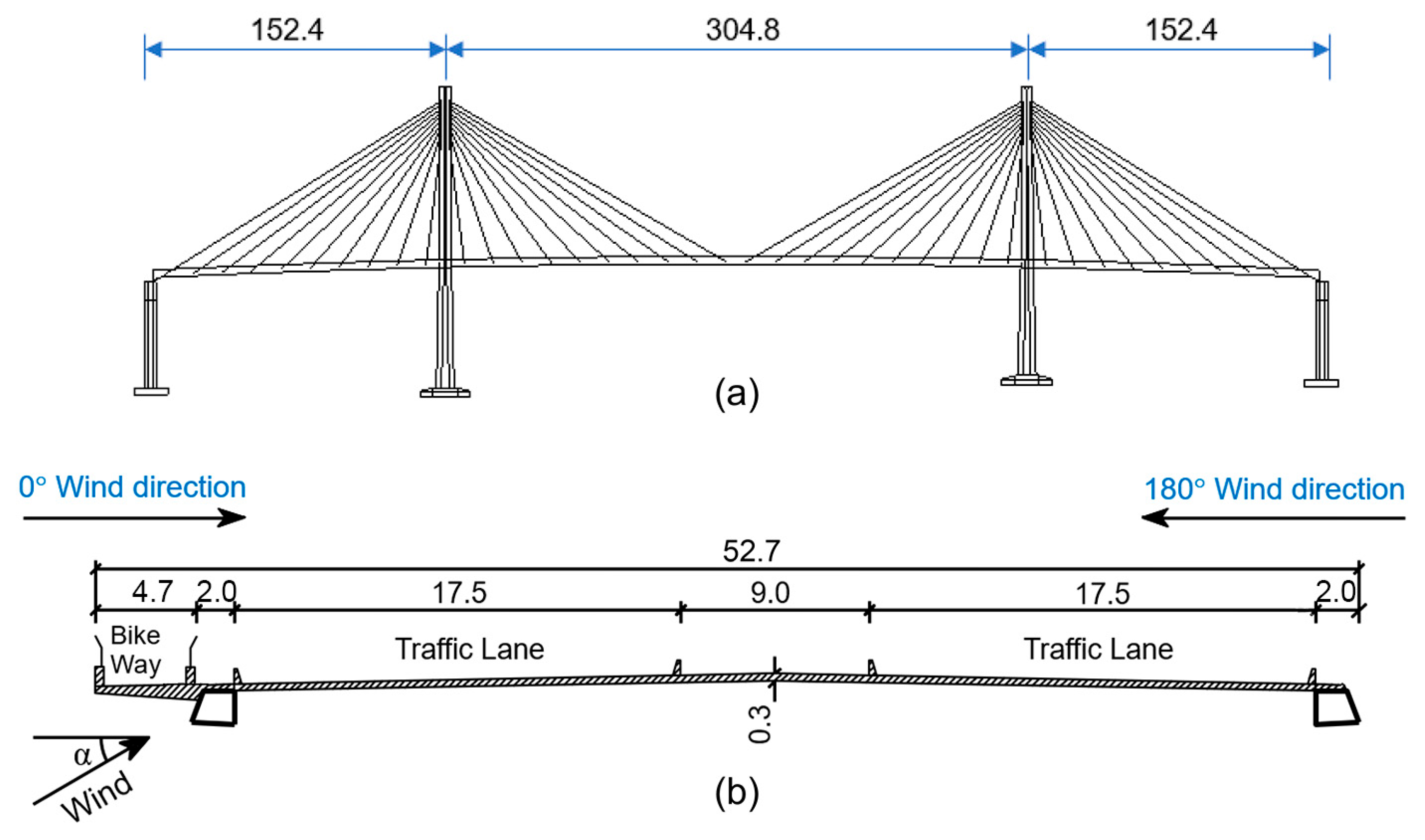
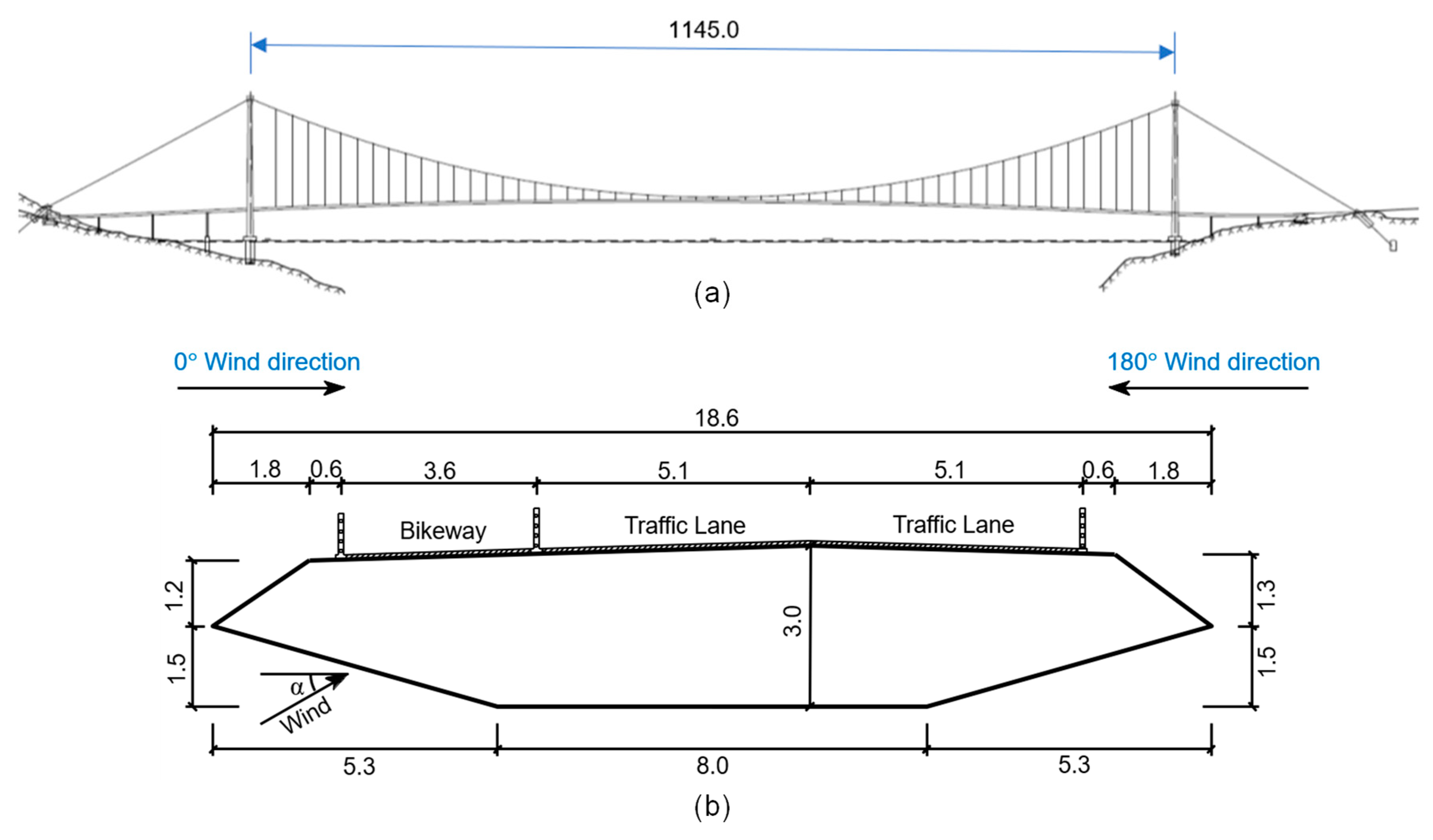
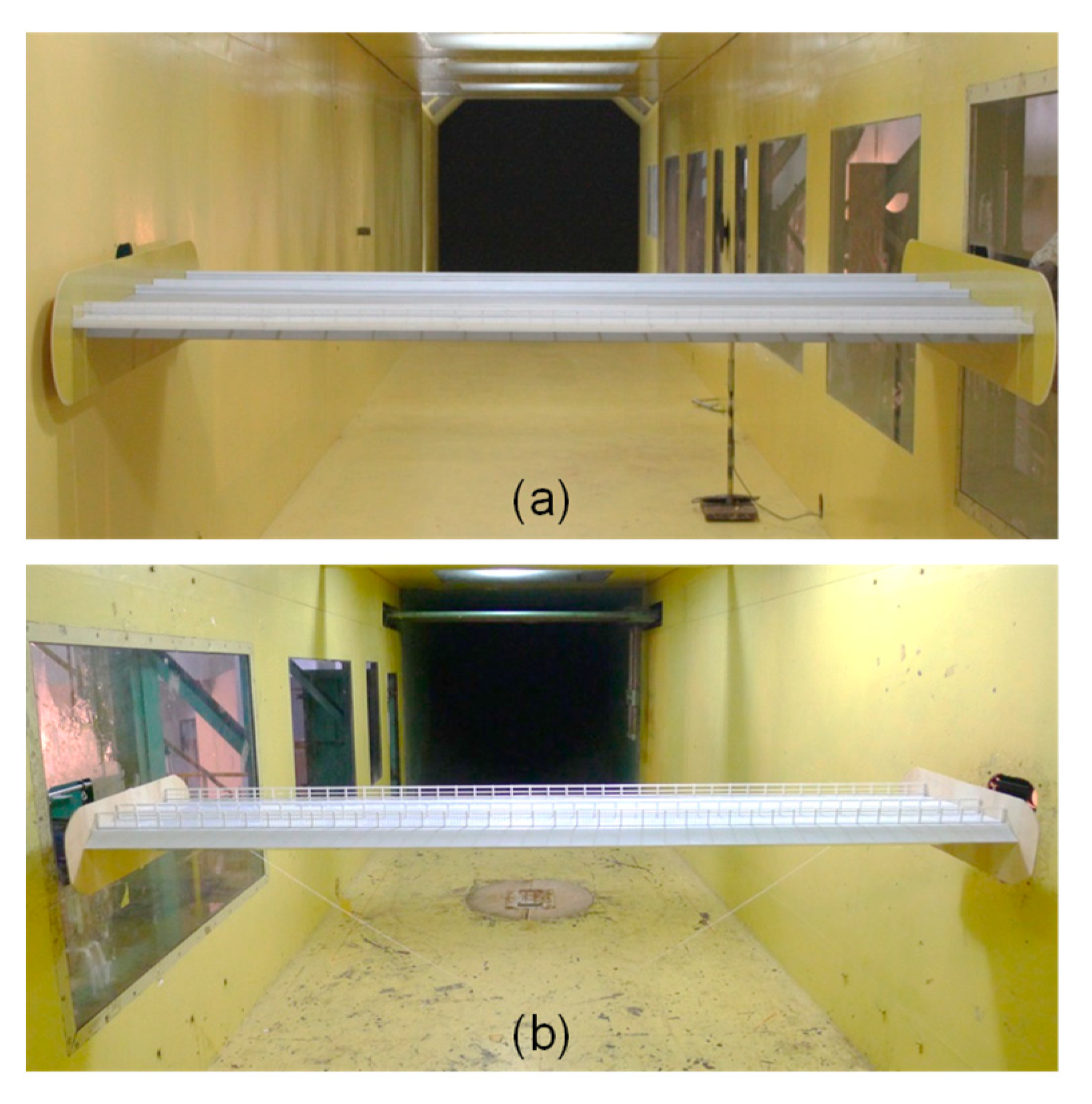
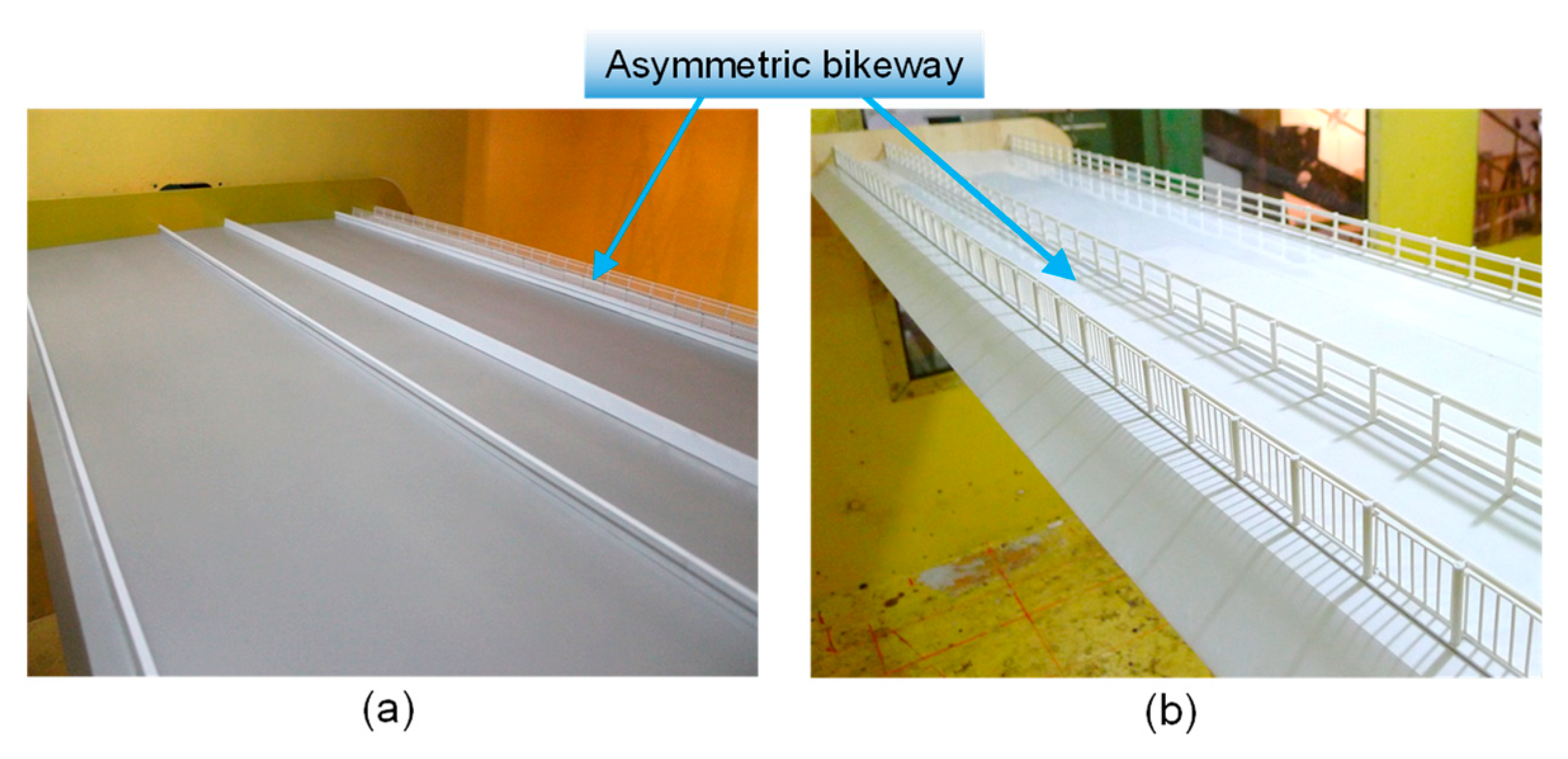
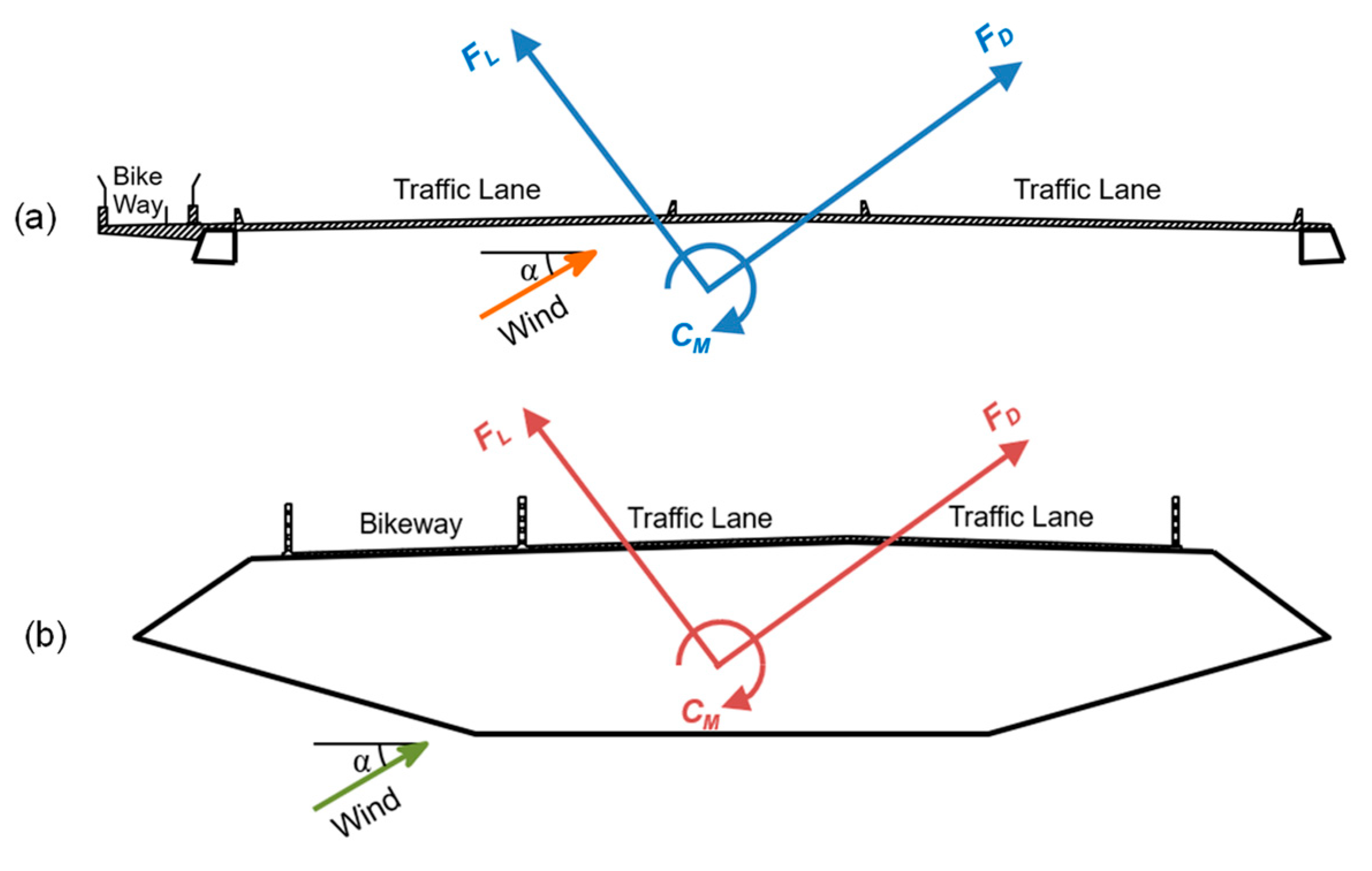

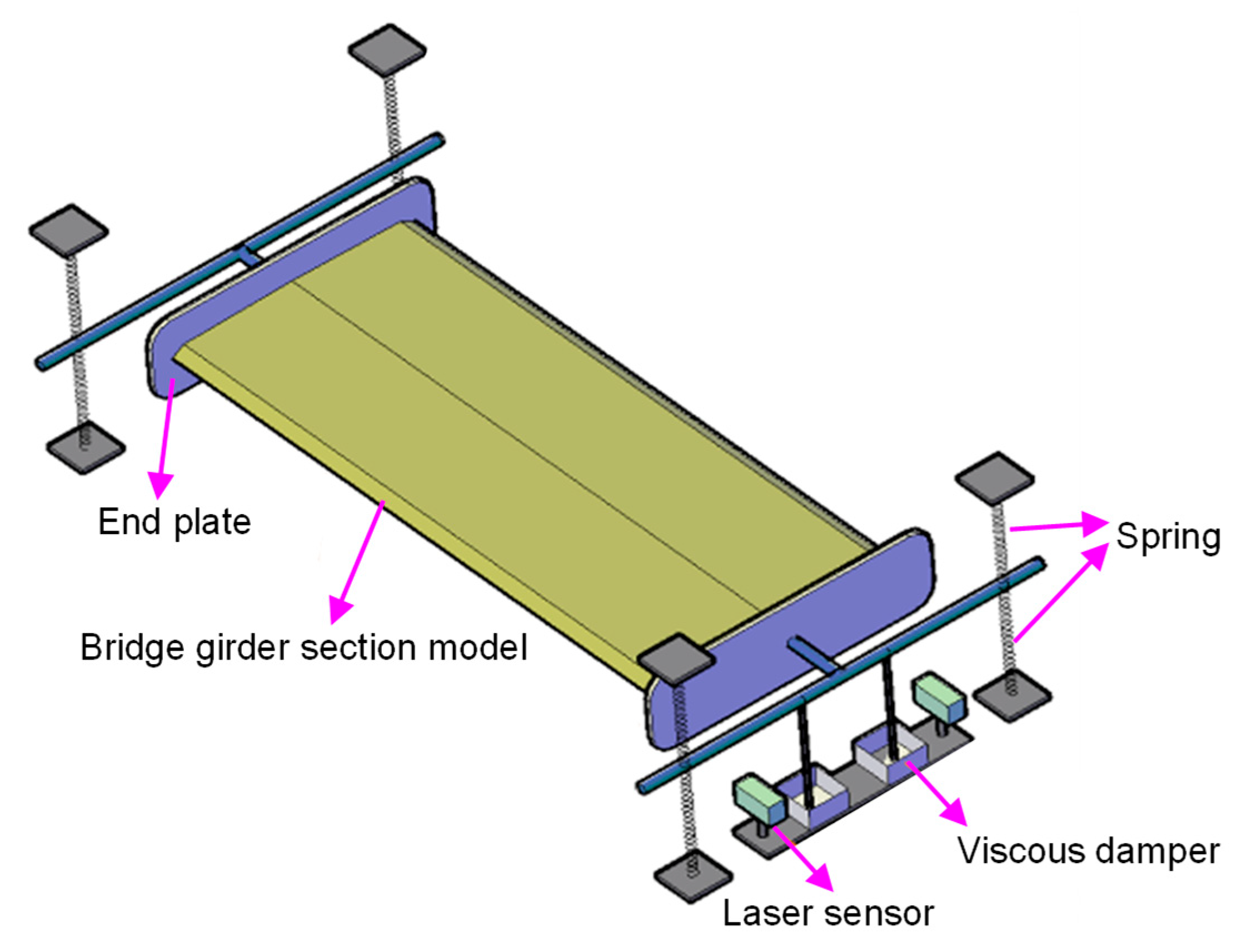

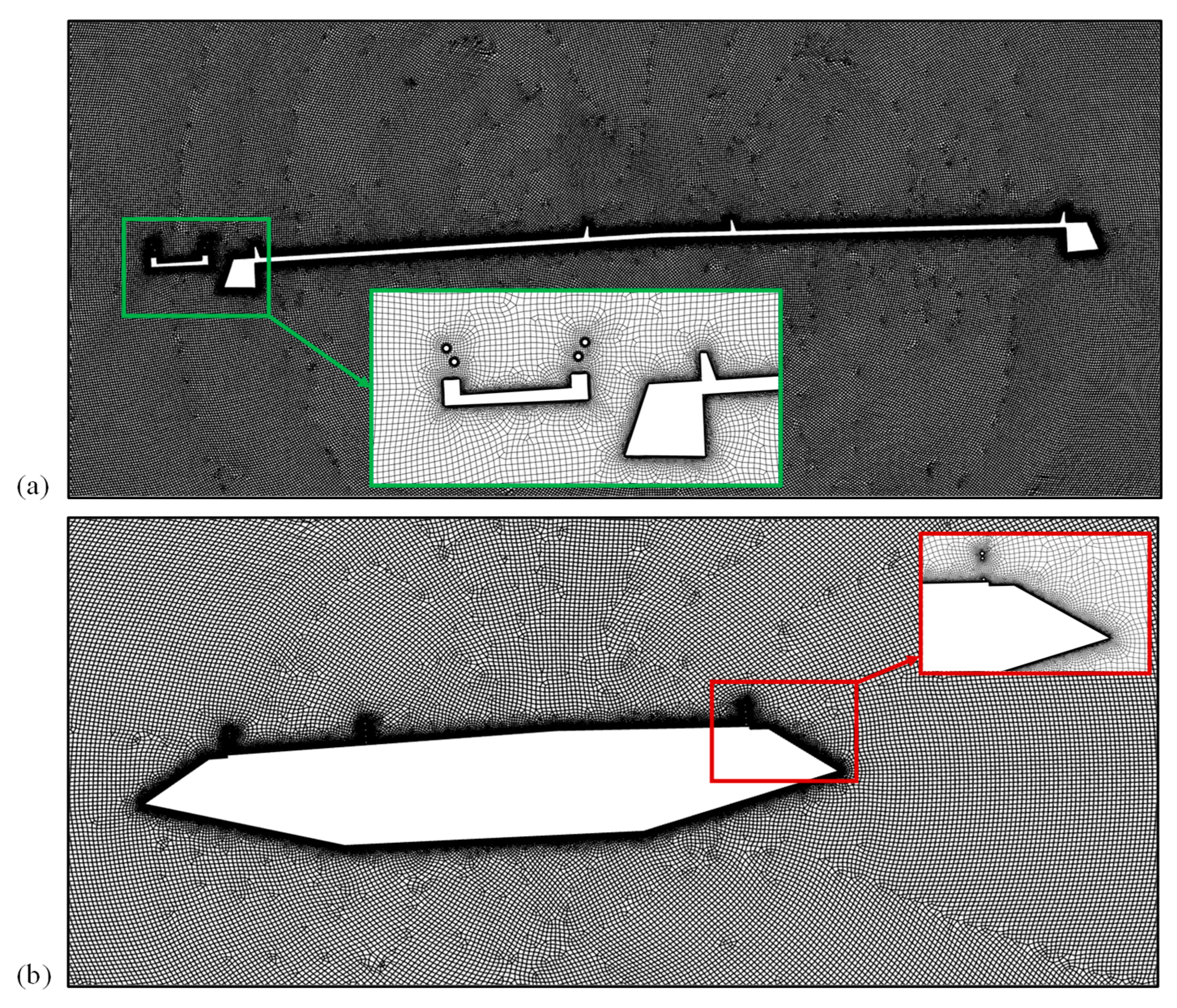
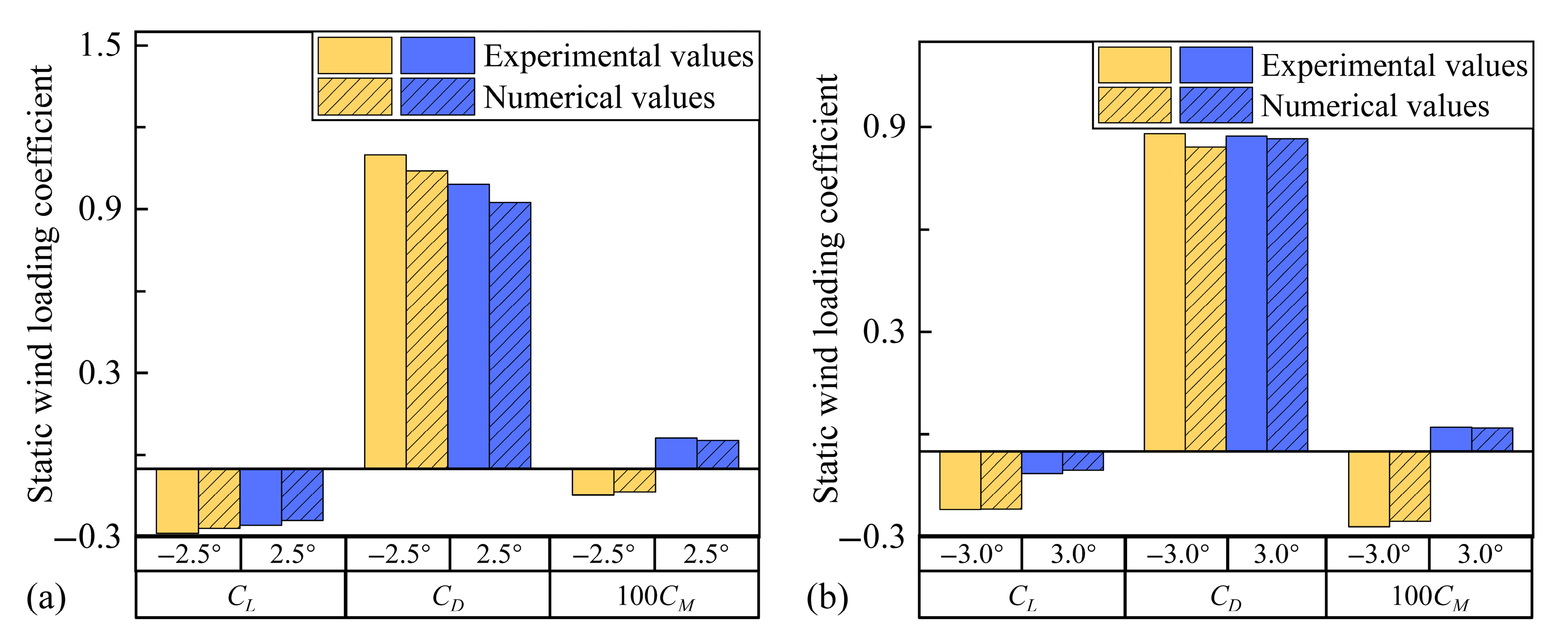
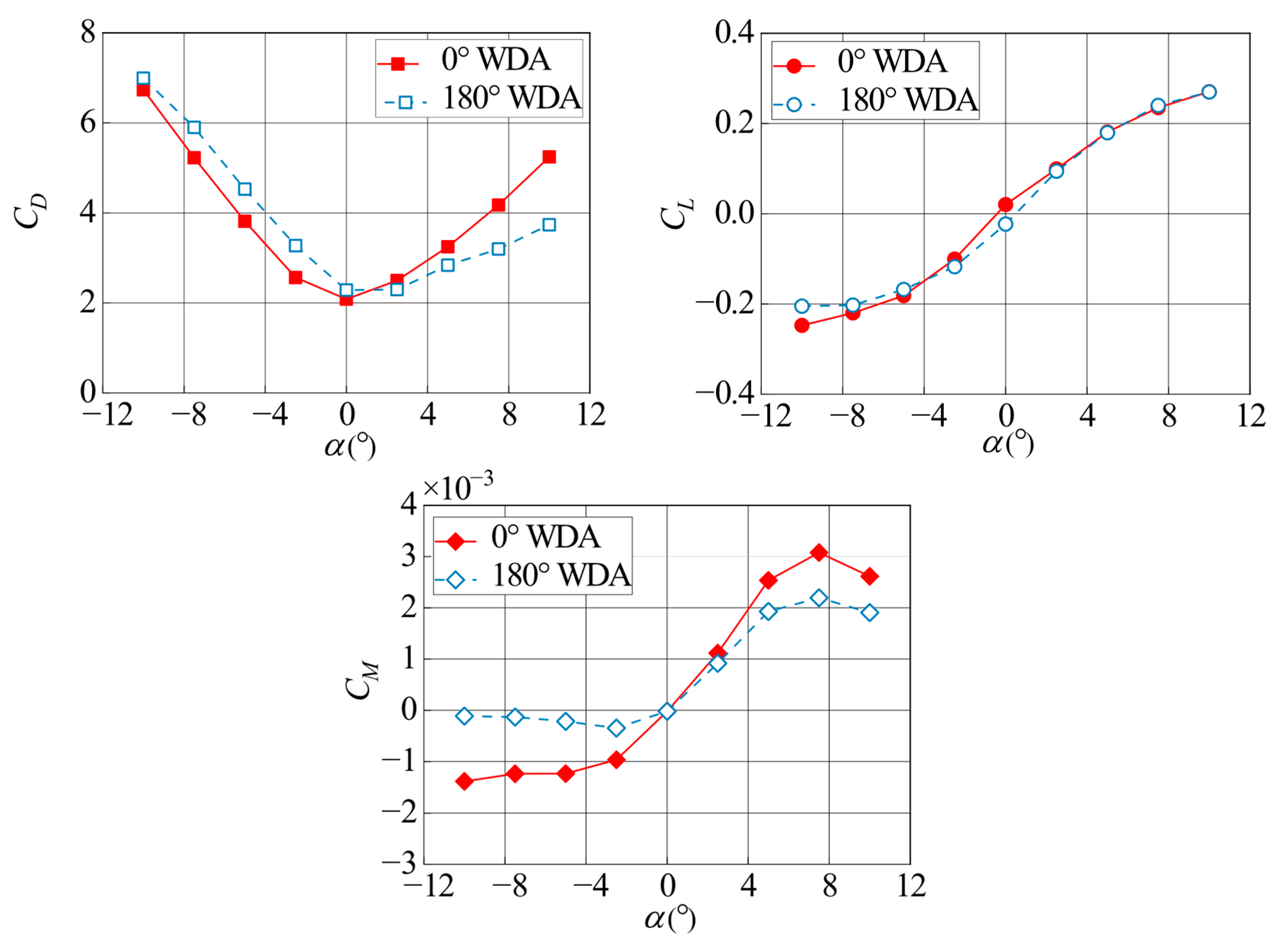
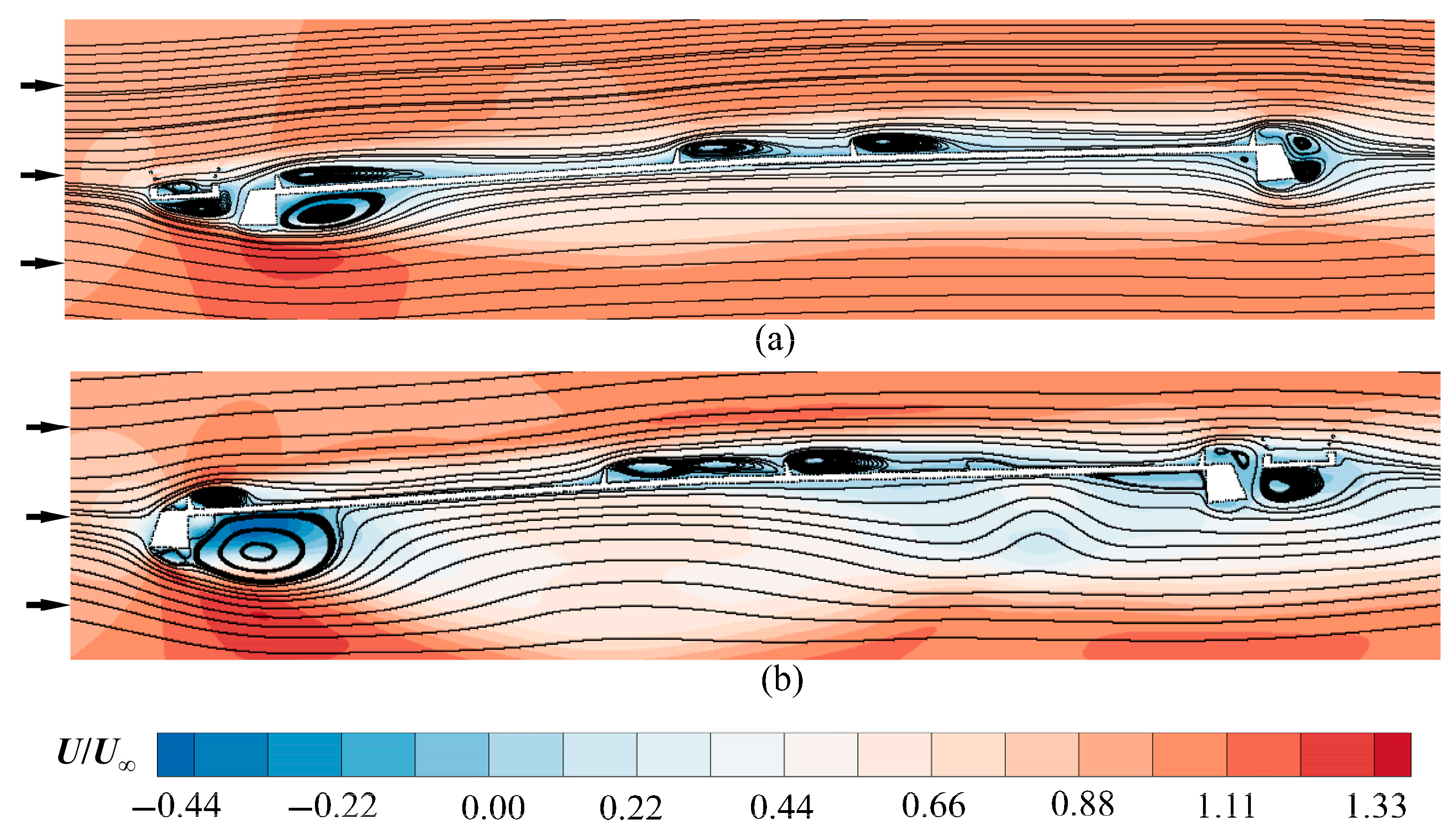

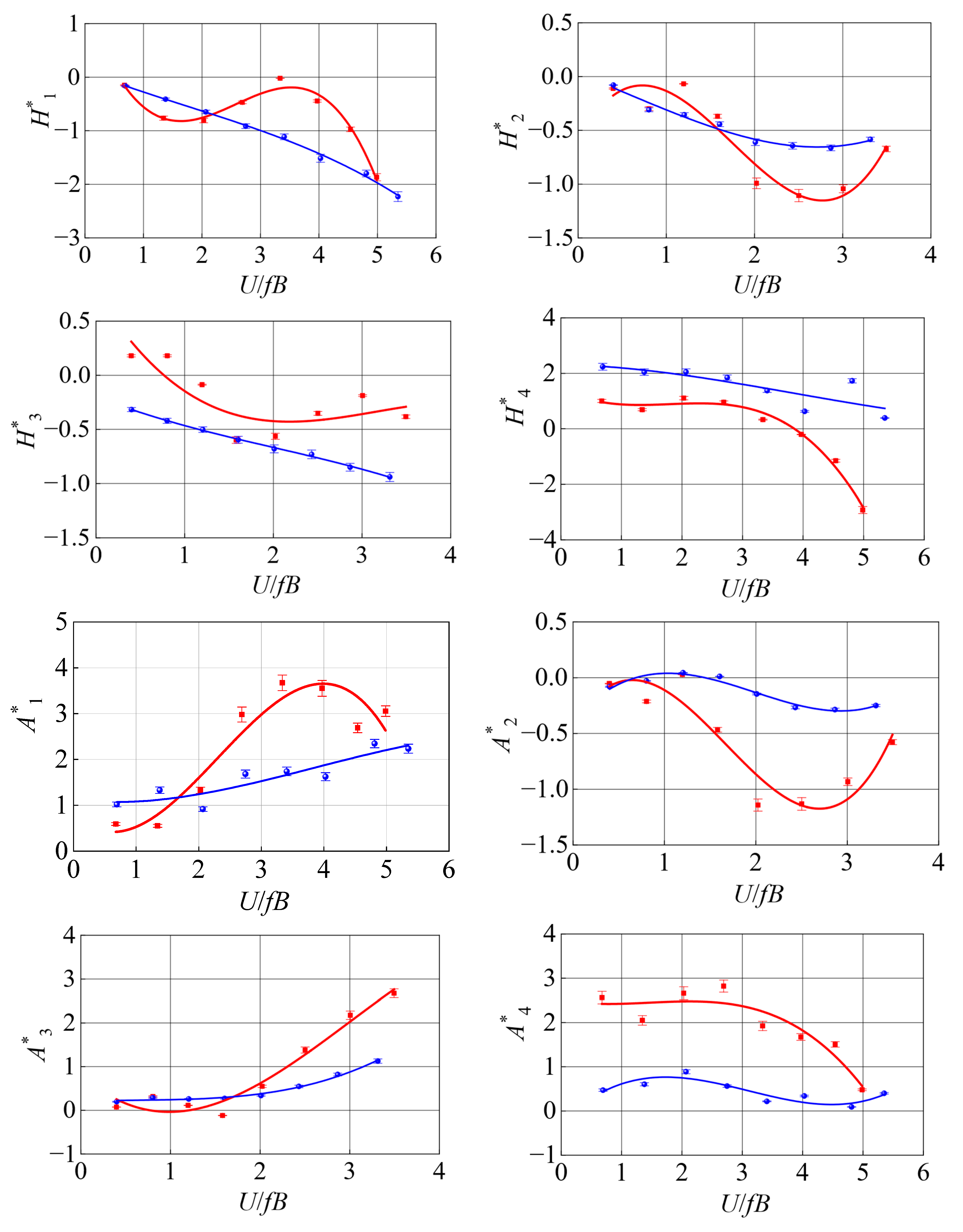
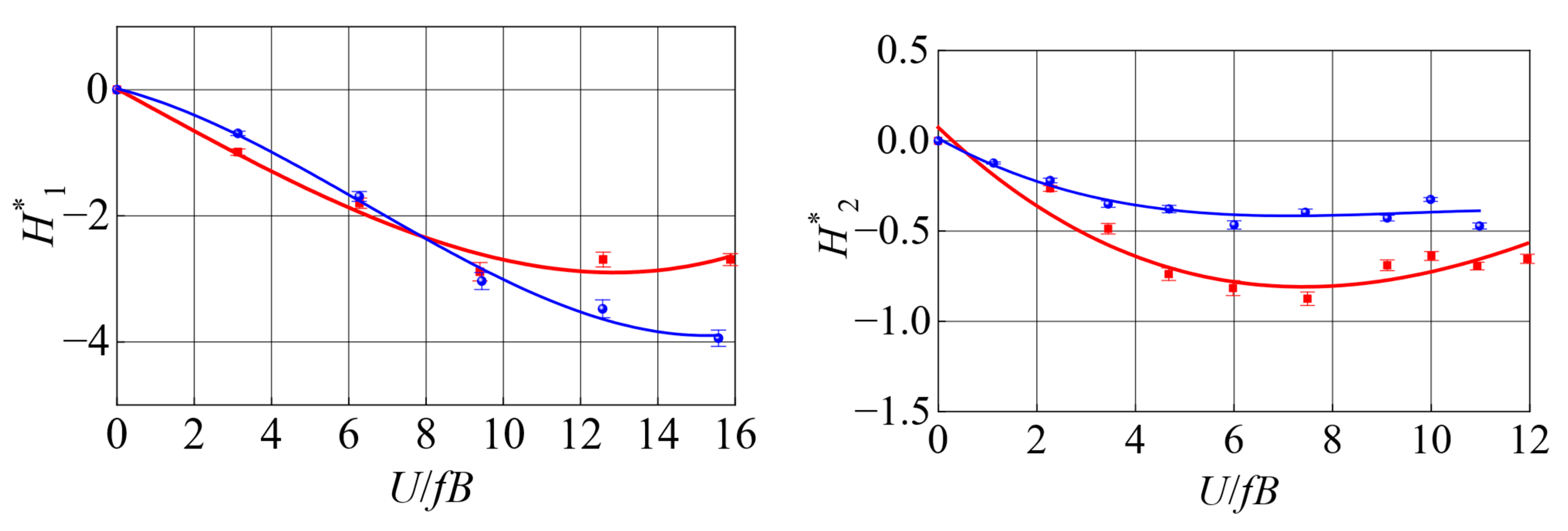

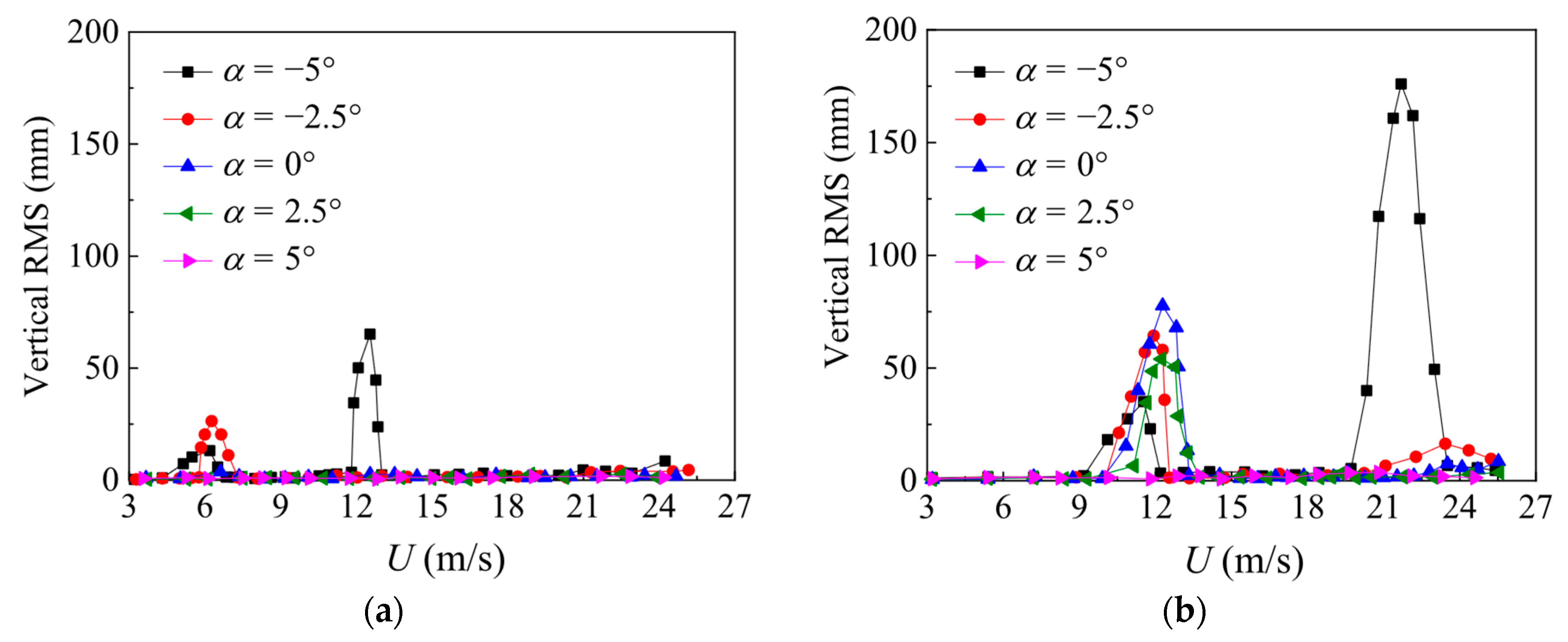
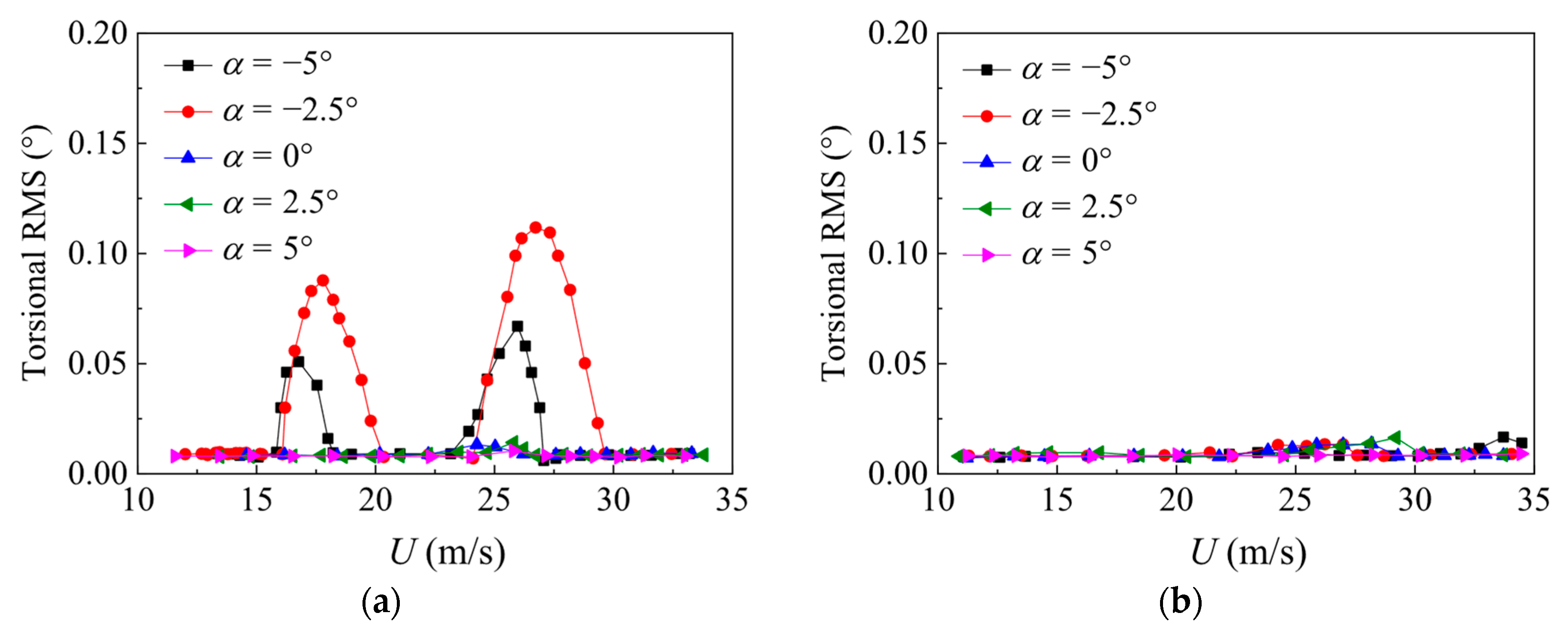
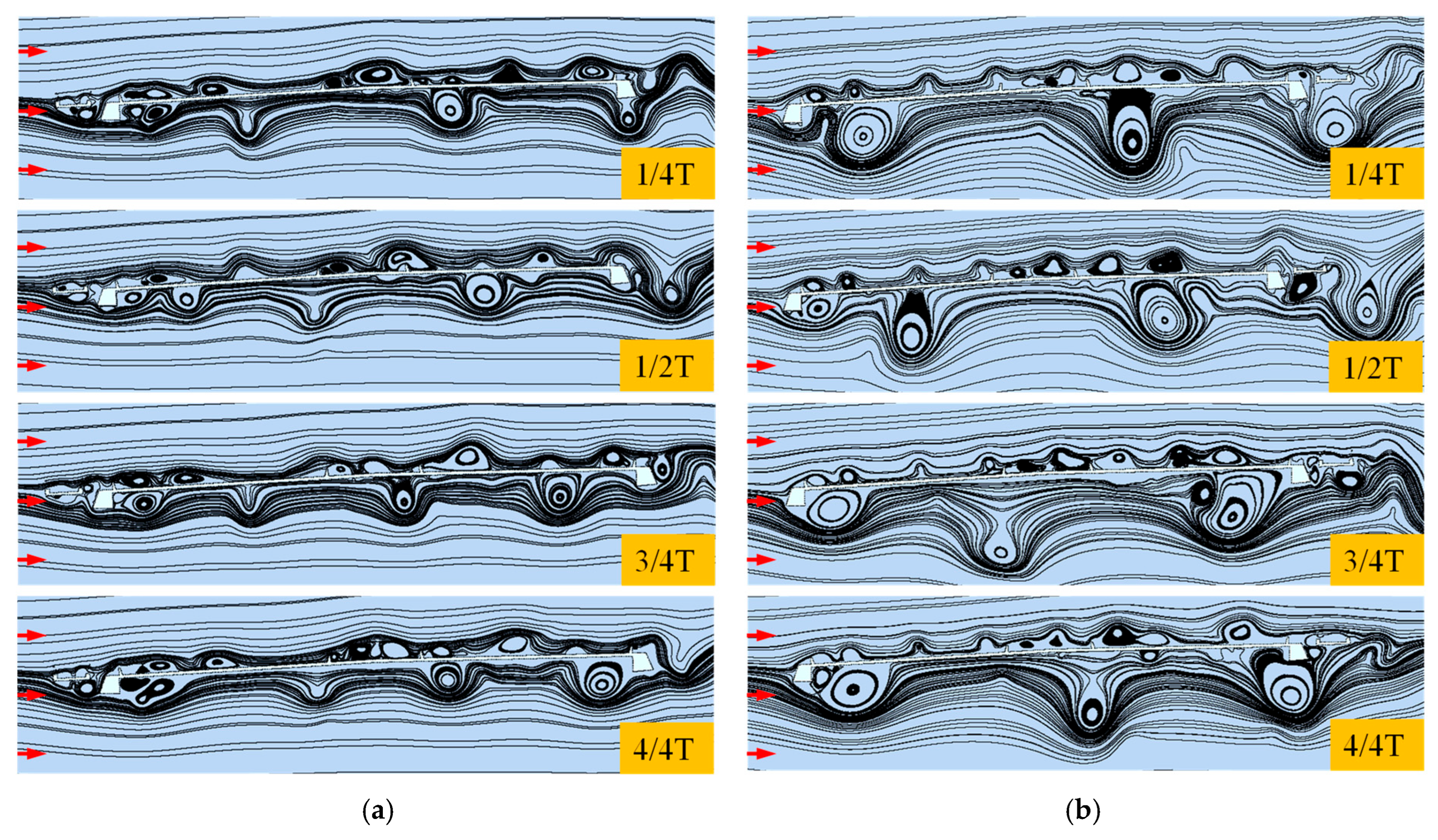
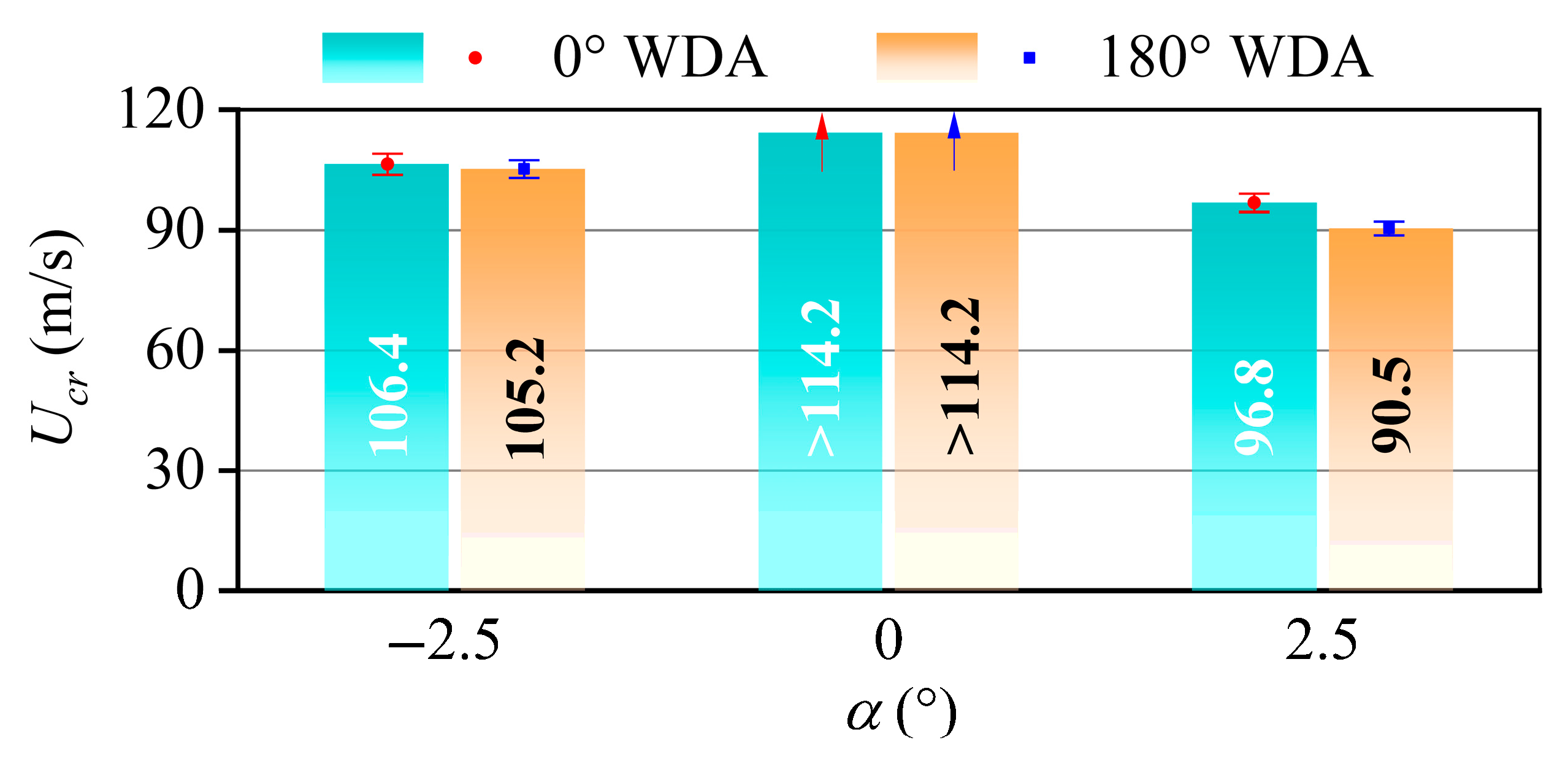
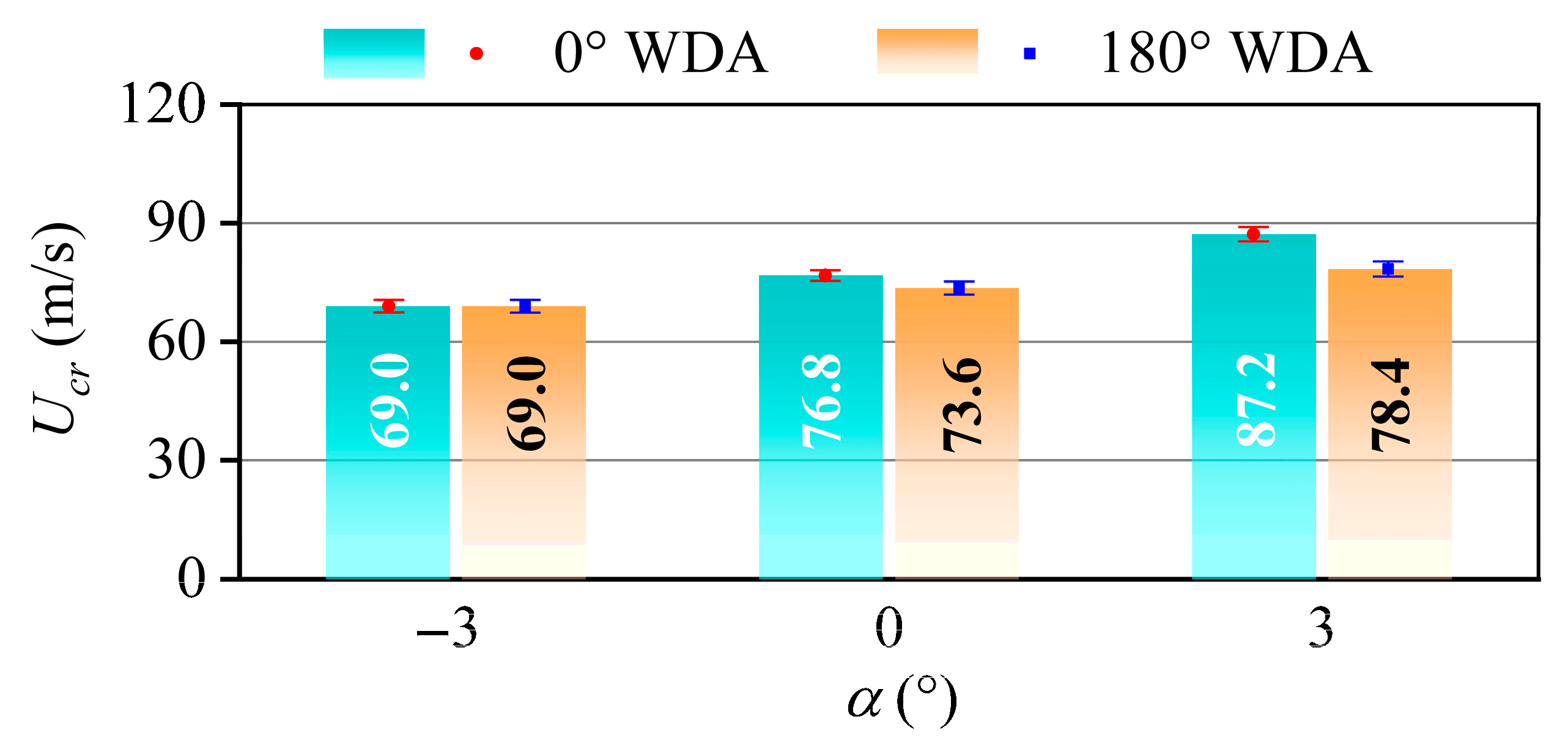
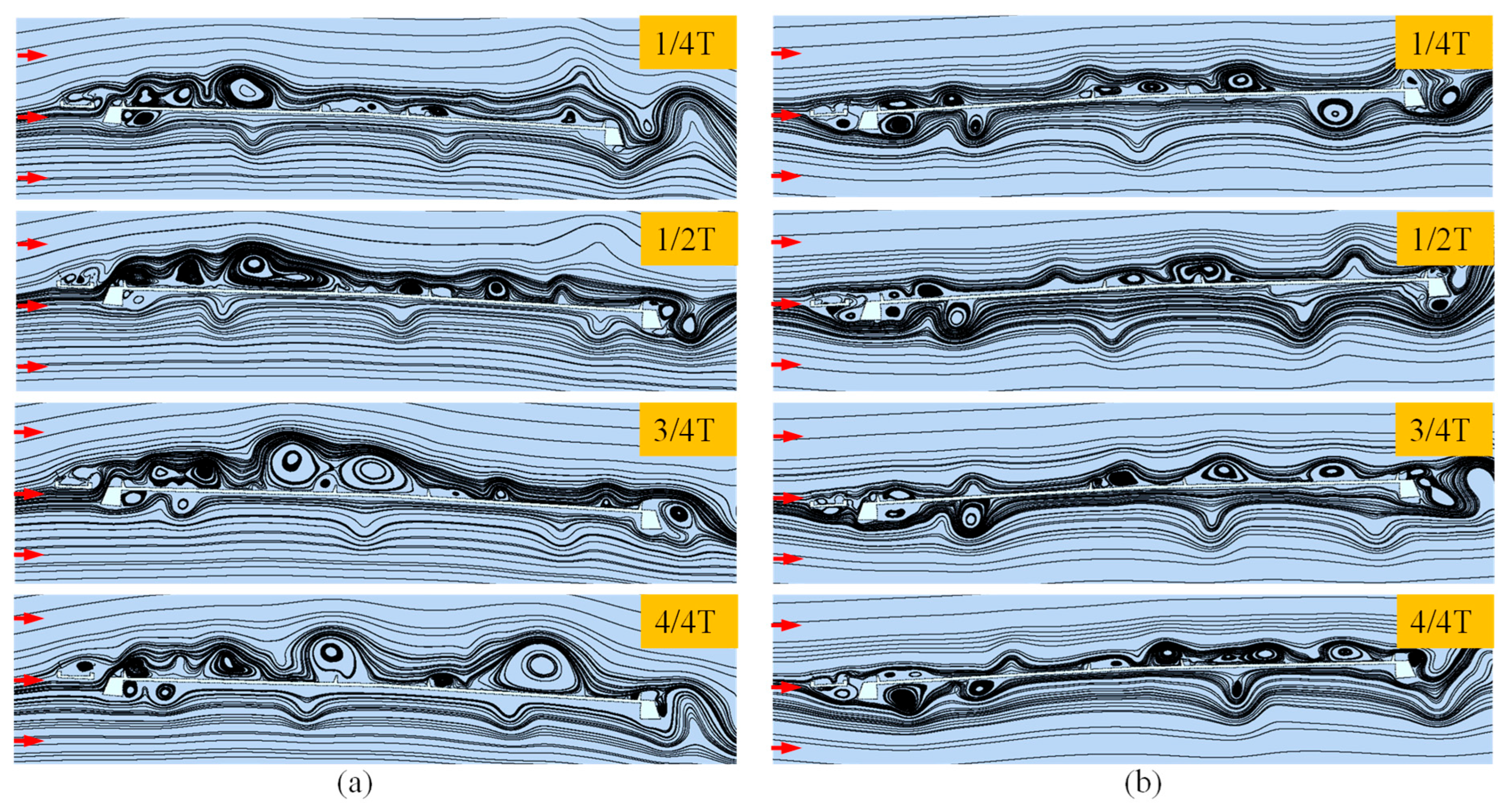

| Item | Parameter and Symbol | Unit | Prototype | Ratio | Model |
|---|---|---|---|---|---|
| Equivalent mass | Mass, m | kg/m | 44,700 | 1:452 | 37.462 |
| Mass moment of inertia, Jm | kg·m2/m | 10,200,000 | 1:454 | 3.413 | |
| Frequencies | V–S–1, fh | Hz | 0.247 | - | 2.870 |
| T–S–1, fθ | Hz | 0.770 | - | 8.843 | |
| Damping ratios | Heaving, ζh | % | - | 1 | 0.373 |
| Torsional, ζθ | % | - | 1 | 0.364 |
| Item | Parameter and Symbol | Unit | Prototype | Ratio | Model |
|---|---|---|---|---|---|
| Equivalent mass | Mass, m | kg/m | 86,300 | 1:402 | 53.938 |
| Mass moment of inertia, Jm | kg·m2/m | 4,370,000 | 1:404 | 1.707 | |
| Frequencies | V–S–1, fh | Hz | 0.148 | - | 1.309 |
| T–S–1, fθ | Hz | 0.409 | - | 3.702 | |
| Damping ratios | Heaving, ζh | % | - | 1 | 0.358 |
| Torsional, ζθ | % | - | 1 | 0.371 |
Disclaimer/Publisher’s Note: The statements, opinions and data contained in all publications are solely those of the individual author(s) and contributor(s) and not of MDPI and/or the editor(s). MDPI and/or the editor(s) disclaim responsibility for any injury to people or property resulting from any ideas, methods, instructions or products referred to in the content. |
© 2025 by the authors. Licensee MDPI, Basel, Switzerland. This article is an open access article distributed under the terms and conditions of the Creative Commons Attribution (CC BY) license (https://creativecommons.org/licenses/by/4.0/).
Share and Cite
Chen, X.; Yu, H.; Yu, H.; Zhao, P.; Li, M. Aerodynamic Loading and Wind-Induced Vibration Characteristics of Bridge Girders with Typical Asymmetric Configurations. Buildings 2025, 15, 2824. https://doi.org/10.3390/buildings15162824
Chen X, Yu H, Yu H, Zhao P, Li M. Aerodynamic Loading and Wind-Induced Vibration Characteristics of Bridge Girders with Typical Asymmetric Configurations. Buildings. 2025; 15(16):2824. https://doi.org/10.3390/buildings15162824
Chicago/Turabian StyleChen, Xingyu, Helu Yu, Haowei Yu, Pinyi Zhao, and Ming Li. 2025. "Aerodynamic Loading and Wind-Induced Vibration Characteristics of Bridge Girders with Typical Asymmetric Configurations" Buildings 15, no. 16: 2824. https://doi.org/10.3390/buildings15162824
APA StyleChen, X., Yu, H., Yu, H., Zhao, P., & Li, M. (2025). Aerodynamic Loading and Wind-Induced Vibration Characteristics of Bridge Girders with Typical Asymmetric Configurations. Buildings, 15(16), 2824. https://doi.org/10.3390/buildings15162824






